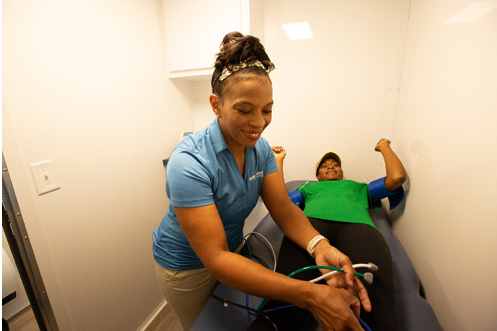 Dr. Richard E. Browne, MD, FACC*
Dr. Richard E. Browne, MD, FACC*
Did you know that heart disease is the leading cause of death in the U.S.? Approximately 650,000 people die from it every year.1 February is Heart Health Month in the U.S. and I’d like to use this as an opportunity to highlight the importance of prevention and proper screening in the fight against heart disease.
There are several risk factors that put people at risk of heart disease, including2:
- High blood pressure
- High blood cholesterol
- Cigarette smoking
- Diabetes
- Obesity
- Family history
- Lack of exercise
- Poor diet
African Americans are more likely to have one or more of these risk factors – for example, high blood pressure affects more than 40% of African Americans, which is 10-12% higher than for non-Hispanic white or Mexican Americans. This in turn means that African Americans are disproportionately affected by heart disease. While this increased risk has been known about for a long time, the amount of heart disease in the African American community remains high. It is one of the key reasons for life expectancy being lower in African Americans than in white Americans.3
The Heart/Leg Connection
Heart disease is related to a process called atherosclerosis, or plaque buildup, which makes it hard for blood to flow.4 This condition also causes Peripheral Artery Disease (PAD), which is a common type of vascular disease that occurs when narrowed blood vessels reduce blood flow to the limbs, most often the legs.2 Many patients may not know they have PAD.2 Despite affecting nearly 20 million Americans, only approximately 8.5 million are diagnosed with it.5,6 PAD can put you at a higher risk for heart attack and stroke, and lead to complications including death and limb amputation.2,3 This is why it is crucial for patients to be screened for PAD.
Most of the risk factors I mentioned above are also linked to PAD.2 These risk factors are disproportionately seen in African Americans and as a result, African Americans are more than twice as likely as white Americans to have PAD.3, 7 While the outcomes of PAD can be serious, early detection and getting the right care can improve those outcomes.2
The signs and symptoms of PAD can vary, but common symptoms to look out for include2:
- Pain while walking
- Leg pain
- Poor nail growth
- Fatigue in the legs
- Skin problems or discoloration on your legs and feet
- Wounds to the legs and feet that are slow to heal
However, some patients may have the disease and not experience any symptoms, which is why it’s so important to be screened for PAD if you’re at risk of the disease.2 While leg pain (also known as claudication) is known to be the classic symptom of PAD, 4 in 10 people with the disease don’t experience that.8 African Americans have a higher prevalence of asymptomatic PAD, meaning that even though they may have the disease, they may not experience leg pain or other symptoms.6 Without these warning signs, there is a greater risk of patients experiencing a delay in receiving the care they need and continuing to carry out behaviors that put them at a higher risk for PAD, such as smoking and lack of exercise.2
Managing PAD
In my experience, most people don’t understand how easy the process of screening for PAD is. Even though some people may not experience symptoms, your doctor can identify signs of PAD through a physical exam, such as a weak or absent pulse below a narrowed area of your artery, listening for “whooshing” sounds over arteries by using a stethoscope, or looking at wounds to see if there is evidence of poor healing in areas where your blood flow is restricted. Your doctor can also use a simple screening test called the ankle-brachial index (ABI). This test involves taking your socks off so your doctor can examine your legs and feet, and then taking your blood pressure in your arm and both ankles. Talking to your doctor about whether you should get screened for PAD, or if anyone in your family has or has ever had PAD, is a great first step towards managing the disease. Importantly, your doctor can also help you identify medications and healthy lifestyle choices that may help reduce your risk of complications or PAD.
As a cardiologist who has been in the field for more than 20 years, I believe that it is crucial for patients and physicians to have an ongoing dialogue, working together to manage health holistically and helping to prevent diseases such as PAD by identifying the signs and symptoms early and by screening appropriate patients. There are several ways to reduce your risk of the disease. These include exercise, quitting smoking, a healthy diet, and taking good care of your feet. However, every patient is different, which is why it’s so important to work with your doctor to identify prevention strategies that work best for you.
This month, I encourage you to learn more about the signs and symptoms of PAD and talk to your doctor about screening and prevention.
*Richard Browne, MD, is a cardiologist with more than 20 years of experience. He graduated with honors from Boston University School of Medicine and completed his internship and medical residency at Harvard Medical School. He then did a cardiology fellowship at the University of Virginia, where he served as the chief cardiology fellow. Currently, Dr. Browne practices at Pure Cardiology in Charlotte, NC, and is a council member for the North Carolina Chapter of the American College of Cardiology. This article was developed by Janssen Pharmaceuticals, Inc., in collaboration with Dr. Browne. He is a paid consultant for Janssen Pharmaceuticals, Inc.
References
- Centers for Disease Control and Prevention. Heart Disease Facts. Available at: https://www.cdc.gov/heartdisease/facts.htm. Accessed January 19, 2021.
- National Heart, Lung, and Blood Institute. Peripheral Artery Disease. Available at: https://www.nhlbi.nih.gov/health-topics/peripheral-artery-disease. Accessed January 19, 2021.
- Carnethon MR, Pu J, Howard G, et al. A Scientific Statement from the American Heart Association. Cardiovascular Health in African Americans. Available at: https://www.ahajournals.org/doi/pdf/10.1161/CIR.0000000000000534. Accessed January 19, 2021.
- American Heart Association. What is Cardiovascular Disease? Available at: https://www.heart.org/en/health-topics/consumer-healthcare/what-is-cardiovascular-disease. Accessed January 19, 2021.
- Racial Disparities in Vascular Care. Available at: https://cardiovascularcoalition.com/our-patients/racial-disparities-in-vascular-care/. Accessed January 19, 2021.
- Centers for Disease Control and Prevention. Peripheral Artery Disease (PAD). Available at: https://www.cdc.gov/heartdisease/PAD.htm. Accessed January 19, 2021.
- Ghidei W, Collins TC. African Americans and Peripheral Arterial Disease: A Review Article. International Scholarly Research Notices. 2012;165653:1-9.
- Virani SS, Alonso A, Benjamin EJ, et al. Heart disease and stroke statistics—2020 update: a report from the American Heart Associationexternal icon. Circulation. 2020;141(9):e139-e596.
